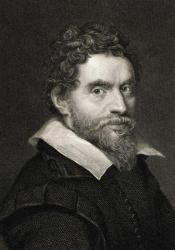Ben Jonson (1572-1637) [HISTORICAL] (Chapter 2 pp. 90)
Ben Jonson is among the best-known writers, theorists, poets and dramatists of English Renaissance literature, known for his four most famous plays, all of which are comedies: Volpone (1606), Epicoene (1609),The Alchemist (1610), and Bartholomew Fair (1614). Jonson’s popularity as a playwright in England was second only to Shakespeare’s; he produced popular masques for the courts of James I and Charles I. In 1616, Jonson was granted a royal pension along with the title of England's Poet Laureate.
In Virgina Woolf's Orlando: An Autobiography (1928), Orlando and Greene muse over the plays of Shakespeare and Jonson as Greene spoke with "a spirit that roused Orlando to the highest pitch of delight" (91). For Orlando, "[t]hese were his gods!" (Woolf 91). Nick Greene redirects Orlando's romanticization of historical characters like Jonson and Shakespeare, to himself and his own life; Greene exposes the poet "gods" as drunkards who simply write for money (Woolf 91). At this point, Orlando feels deeply troubled by "how active and valiant they were in body" and "how slothful and timid in mind" (Woolf 92). Just as Orlando questions how these contradictions coalesce, several of Jonson's writings explore a similar equilibrium. Thomas M. Greene in his article, "Ben Jonson and the Centered Self," claims "everything Jonson wrote attempts in one way or another to complete the broken circle, or expose the ugliness of its incompletion" (325). A completed circle is "durable, as center-oriented and centripetal," while an incompleted circle can be described as "moving free, as disoriented and centrifugal, in quest of transformation" (Greene 326). This is particularly pertinent to Orlando's identity, one which is fluid, yet must participate in a world that is balancing completion and incompletion.
Woolf, Virginia. Orlando: A Biography. Harcourt Brace Jovanovich, 1992.
Greene, Thomas M. “Ben Jonson and the Centered Self.” Studies in English Literature, 1500-1900, vol. 10, no. 2, 1970, pp. 325–348., doi:10.2307/449921.

